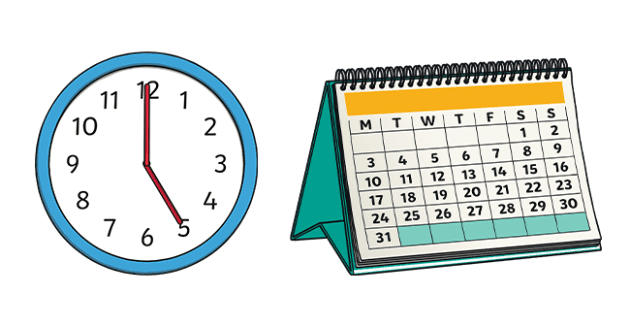ADVERBS OF TIME
EF - Education First
Adverbs of time tell us when an action happened, but also for how long, and how often. Adverbs of time are invariable. They are extremely common in English. Adverbs of time have standard positions in a sentence depending on what the adverb of time is telling us.
Adverbs that tell us when
Adverbs that tell us when are usually placed at the end of the sentence.
- Goldilocks went to the Bears' house yesterday.
- I'm going to tidy my room tomorrow.
- I saw Sally today.
- I will call you later.
- I have to leave now.
- I saw that movie last year.
- Later Goldilocks ate some porridge. (the time is important)
- Goldilocks later ate some porridge. (this is more formal, like a policeman's report)
- Goldilocks ate some porridge later. (this is neutral, no particular emphasis)
Adverbs that tell us for how long are also usually placed at the end of the sentence.
- She stayed in the Bears' house all day.
- My mother lived in France for a year.
- I have been going to this school since 1996.
- I stayed in Switzerland for three days.
- I am going on vacation for a week.
- I have been riding horses for several years.
- The French monarchy lasted for several centuries.
- I have not seen you since Monday.
- Jim has been working here since 1997.
- There has not been a more exciting discovery since last century.
Adverbs that tell us how often express the frequency of an action. They are usually placed before the main verb but after auxiliary verbs (such as be, have, may, and must). The only exception is when the main verb is "to be", in which case the adverb goes after the main verb.
- I often eat vegetarian food.
- He never drinks milk.
- You must always fasten your seat belt.
- I am seldom late.
- He rarely lies.
Click on the image to expand it.
Some other adverbs that tell us how often express the exact number of times an action happens or happened. These adverbs are usually placed at the end of the sentence.
- This magazine is published monthly.
- He visits his mother once a week.
- I work five days a week.
- I saw the movie seven times.
Using "yet"
Yet is used in questions and in negative sentences to indicate that something that has not happened or may not have happened but is expected to happen. It is placed at the end of the sentence or after not.
- Have you finished your work yet? (= simple request for information)
- No, not yet. (= simple negative answer)
- They haven't met him yet. (= simple negative statement)
- Haven't you finished yet? (= expressing surprise)
Using "still"
Still expresses continuity. In positive sentences it is placed before the main verb and after auxiliary verbs such as be, have, might, will. If the main verb is to be, then place still after it rather than before. In questions, still goes before the main verb.
- She is still waiting for you.
- Jim might still want some.
- Do you still work for the BBC?
- Are you still here?
- I am still hungry.
Order of adverbs of time
If you need to use more than one adverb of time in a sentence, use them in this order:
1: how long / 2: how often / 3: when
- 1 + 2 = I work (1) for five hours (2) every day.
- 2 + 3 = The magazine was published (2) weekly (3) last year.
- 1 + 3 = I was abroad (1) for two months (3) last year.
- 1 + 2 + 3 = She worked in a hospital (1) for two days (2) every week (3) last year.
Adapted from: https://www.ef.com/wwen/english-resources/english-grammar/adverbs-time/. © Signum International AG 2023. All rights reserved.






No comments:
Post a Comment